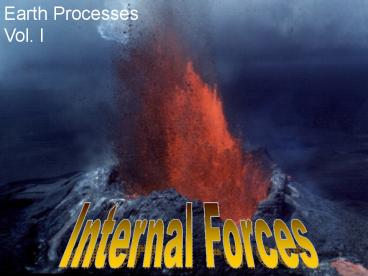Earth Processes Vol. I - PowerPoint PPT Presentation
1 / 32
Title:
Earth Processes Vol. I
Description:
Seismograph A tool used to measure the energy or the force of an earthquake. Epicenter ... that uses information collected by seismographs to rank the size of ... – PowerPoint PPT presentation
Number of Views:35
Avg rating:3.0/5.0
Title: Earth Processes Vol. I
1
Earth Processes Vol. I
Internal Forces
2
Plate Tectonics The idea that the Earths crust
is made up of large plates that float on top of
the upper mantle.
3
They are constantly recycling as magma rises up
and cools and layers of rock are forced downward
and melt.
4
Plate Tectonics The idea that the Earths crust
is made up of large plates that float on top of
the upper mantle.
5
Plate Boundaries The areas where one plate
stops and another begins.
Marks Plate Boundaries
6
Three types of boundaries mark plate movement.
7
Divergent Plates move apart or spread. Magma
pushes its way up between them and fills in the
gap.
8
Convergent
- Plates collide sometimes causing one plate to
dive under or - go over the other plate and sometimes causing the
plates to fold up.
9
Convergent Subduction one plate dives under
another. When an ocean plate collides with a
continental plate, the heavier ocean plate will
dive under the continental plate. This type of
boundary often time creates a volcanic zone.
10
Convergent Collision two continental plates
collide and fold up against each other often
forming mountain ranges.
11
Transform Plates slide past each other. These
type of boundaries cause earthquakes.
12
Fault A fracture or break in the Earths crust
where plates move against each other.
13
Continental drift theory A theory developed in
1912 by Alfred Wegener that stated that the
Earths continents are slowly drifting apart and
were once part of a large super continent where
all the Earths land was connected.
14
Pangea The term for this super continent. It
comes from a Greek word meaning all Earth.
15
It is now believed that the Continents are still
actively drifting and that Pangea has been formed
several times over millions of years.
16
(No Transcript)
17
Earth Quakes a tremendous amount of pressure
can build up along Transform faults and sometimes
this pressure can release suddenly and violently
in the form of an earthquake.
18
Seismograph A tool used to measure the energy
or the force of an earthquake.
19
Epicenter
- Epicenter The center of an earthquakes
destructive force.
20
Richter Scale
- a tool that uses information collected by
seismographs to rank the size of an earthquake.
A 2 or less would be hardly noticeable and the
biggest one in history was an 8.9 in 1989 in the
South Pacific.
21
Tsunami when an earthquake occurs in the ocean
it can create a very large and destructive wave
called a Tsunami.
22
(No Transcript)
23
Volcanoes Natural formations where magma and
gasses are forced from below the Earths surface
to land.
24
There are several types of Volcanic Eruptions
ranging from extremely destructive to something
neat to look at.
25
Mt. St. Helens - Before
26
And after.
27
Hotspots Thin areas in the Earths crust where
magma regularly flows to the surface.
28
A couple of examples of these are the Hawaiian
Islands and the Mid Atlantic Ridge.
29
(No Transcript)
30
(No Transcript)
31
Ring of Fire A name given to a pattern of
Volcanoes that exist along the boundaries of the
Pacific Plate.
32
The pattern of Volcanoes forms a large ring and
therefore it was named The Ring of Fire































